« April 2007 | Main | January 2008 »
June 30, 2007
Viet Nam - Hanoi & Halong Bay
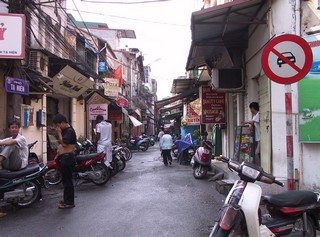 Sunday, June 3rd after breakfast we headed from our hotel in Ho Chi Minh City to the airport for our 2 hour flight to Hanoi, arriving about 1:30 pm.
Sunday, June 3rd after breakfast we headed from our hotel in Ho Chi Minh City to the airport for our 2 hour flight to Hanoi, arriving about 1:30 pm.
Immediately after checking in to the Sheraton Hotel, we were given a pedicab tour of the Old Quarters.
June is into the rainy season which means that at any time the heavens will open. We had to take refuge in a sidewalk cafe to escape the downpour.
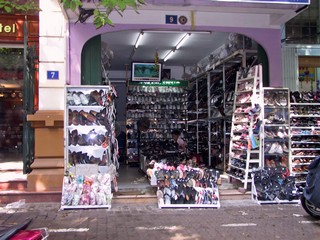
The Old Quarters is made up of about 36 shopping streets, each street named for its primary goods. This picture was taken on the “footwear” street. We also saw, “silver”, “paper” “flowers” and many other specialities. The streets are very narrow and cars are not allowed down them. As the vendors were taxed on the width of their stalls, living quarters and workshops went to the back, creating “tube houses”, 3 meters wide by up to 60 meters deep.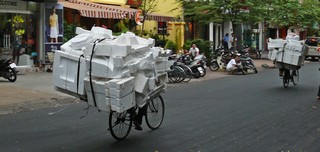 .
.
We saw many unusual products being transported by bicycle.
Labour is cheap as evidenced by the woman cleaning the side of the road with a twig broom.
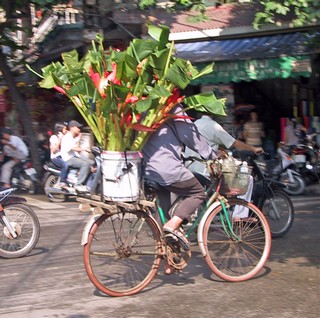
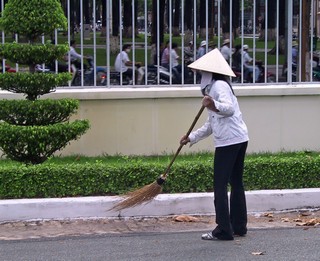
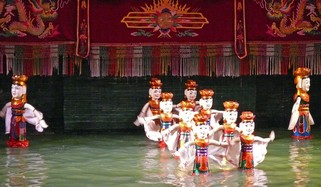
After the tour of the city we were treated to a performance of the Thang Long Water Puppet Theatre. Instead of being controlled by strings from above, the puppeteers are behind the backdrop and manipulate the puppets by long poles that are concealed by the water. A most unique show!
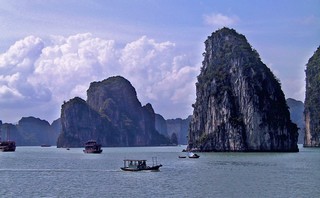 Ha Long Bay – a seascape of limestone mountains, emerging from a clear blue sea.
Ha Long Bay – a seascape of limestone mountains, emerging from a clear blue sea.
On Monday the 4th, we took a full day trip to visit this beautiful area, 165 km from Hanoi.
On arrival at Ha Long City, we boarded a boat and had a two hour cruise through these wonderful shapes. Lunch was served on board and Bernie bought some lovely pearls. The boat in the picture below is similar to the one we were on.
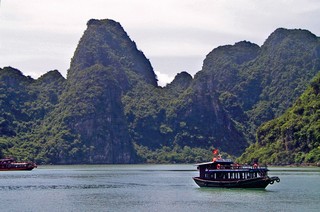
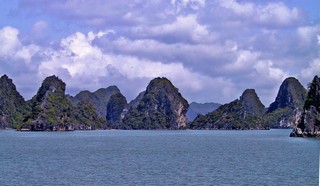
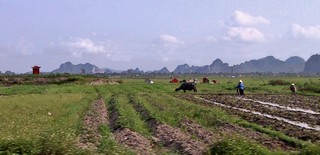
The area between Hanoi and Ha Long Bay has thousands of acres of rice paddies and all of it appears to be farmed by hand, primarily by the women.
It was about 34C (95F) and they were dressed in long pants, smocks with long sleeves and conical hats. The rice sheaves were hand cut and tied and then loaded on to a cart that was pulled by one woman and pushed by another to the side of the road.
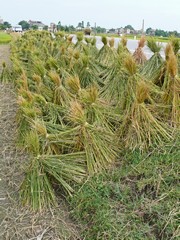
The sheaves were lined up along the edge of the road to dry. When dry they were taken, again by cart, to the threshing machine (the only mechanical item we saw).
From there, the rice were spread out on the driveways to finish drying and to be cleaned of chaff, before it was sold.
The chaff was removed by pouring the grain from basket to basket with the wind blowing.
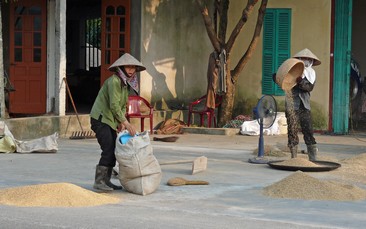
In the morning of our last full day in Vietnam, June 5th, we visited the tomb of Ho Chi Minh, the most important figure in modern Vietnam History.
In Vietnam today, Ho Chi Minh, the man is considered to be the very soul of the countries struggle for independence.
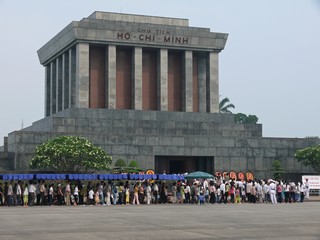 He died in Ha Noi in Sept. 1969 and his embalmed body is on display in a mausoleum which was erected in his honour at the end of the war in 1975. The mausoleum is modelled after Lenin’s Tomb in Moscow. Our guide told us that every day thousands of admirers file past his body, rain or shine, often lining up long before dawn.
He died in Ha Noi in Sept. 1969 and his embalmed body is on display in a mausoleum which was erected in his honour at the end of the war in 1975. The mausoleum is modelled after Lenin’s Tomb in Moscow. Our guide told us that every day thousands of admirers file past his body, rain or shine, often lining up long before dawn.
Interestingly, this “honour” is not what he wished. He wanted to be cremated and his ashes buried in urns on hilltops of Viet Nam.
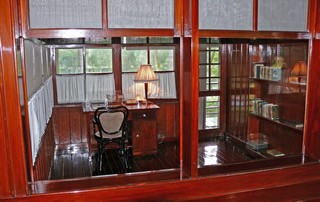
Ho Chi Minh was a very simple person and lived in a very small house, on stilts, close to where the Mausoleum is situated.
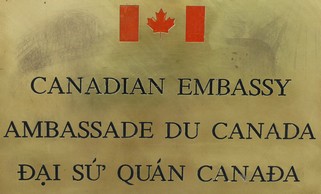
The Canadian Embassy is located at the approach to the Mausoleum Square. We tried to get a picture of it, but the Vietnamese guards would not allow us to take any of the buildings. They finally let us take one of the plaque.
That afternoon we spent walking around the local area. As we crossed one of the local streets, we noticed again that to successfully navigate it, once you start, you don’t stop. When we got to the other side, Ross said “It doesn’t even bother me anymore – It’s interesting what you can get used to”.
The next morning at 11:05 am, we flew out of Hanoi to Hong Kong on our first leg of the flight home. We finally arrived at Toronto airport at 10:00 pm that night. Given the time change and crossing the international date line, we had been en route home for 23 hours.
At times it is hard to believe that we were really there, it seems almost like a dream. But then, we look at the pictures and we really were standing on The Great Wall and walking through Angkor Wat.
A trip of a lifetime.
Bernie & Ross
Posted by Bernice at 11:30 PM | Comments (4)
June 28, 2007
Viet Nam - Ho Chi Minh City - (Saigon)
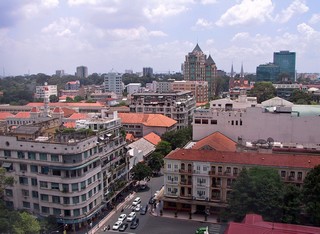 We arrived in Ho Chi Minh City (formerly Saigon) late in the evening on May 31st and as always were met at the airport by our guide. Our accommodation was at the historic Caravelle Hotel right in the middle of the city. During the 60’s the Caravelle was home to the Australian and New Zealand Embassies, the offices for the Associated Press, NBC, CBS, the New York Times and the Washington Post to name a few.
We arrived in Ho Chi Minh City (formerly Saigon) late in the evening on May 31st and as always were met at the airport by our guide. Our accommodation was at the historic Caravelle Hotel right in the middle of the city. During the 60’s the Caravelle was home to the Australian and New Zealand Embassies, the offices for the Associated Press, NBC, CBS, the New York Times and the Washington Post to name a few.
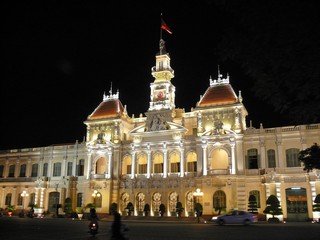 Viet Nam has a vibrant feel and is a country of young people. We were told that about 70% of the citizens have been born since the “American War”. To the majority of citizens the war is only history.
Viet Nam has a vibrant feel and is a country of young people. We were told that about 70% of the citizens have been born since the “American War”. To the majority of citizens the war is only history.
The temperature during the day was about 35C (95F) with high humidity, so it is at night that the City really comes alive. City Hall is impressive the way it is lit up at night.
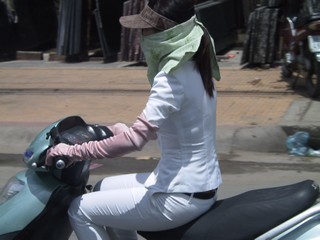 During the day, most of the ladies are totally covered up to protect themselves from the sun. Our guide told us that the young women do this to keep their complections as pale as possible. But when the sun goes down, the cover-ups disappear and they, their families and hundreds of other citizens emerge into the streets of the city to eat, visit and play. As we strolled in the evening, we felt totally safe with so many people around.
During the day, most of the ladies are totally covered up to protect themselves from the sun. Our guide told us that the young women do this to keep their complections as pale as possible. But when the sun goes down, the cover-ups disappear and they, their families and hundreds of other citizens emerge into the streets of the city to eat, visit and play. As we strolled in the evening, we felt totally safe with so many people around. 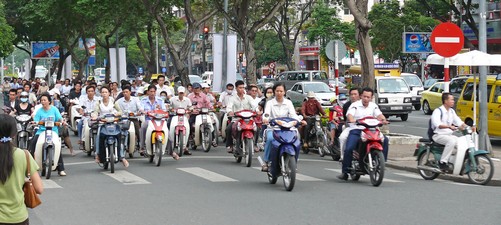
This is rush hour in Ho Chi Minh City.
The first morning we drove about 75 km from the centre of Ho Chi Minh City to the Cu Chi Tunnels – a strategically important war zone. Originally constructed by the Viet Minh during the war with the French, the tunnels were repaired and expanded in the early 1960s, by the Viet Cong.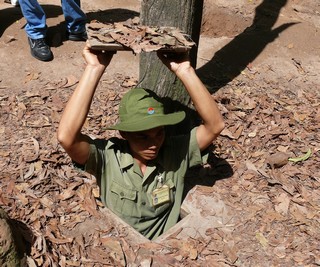
There were about 200 kilometres of tunnels, said to be several stories deep and able to hold up to 10,000 soldiers. There was an underground hospital, kitchen, dining room and command post. As you can see by the picture, the soldiers were small and they literally disappeared before our eyes as they sank into the ground. We also saw some absolutely gruesome booby traps that were used.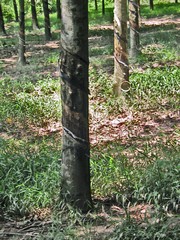
We stopped at a rubber plantation to see how they gathered the secretions from the trees.
In a lot of ways it reminded us of how we gather sap from maple trees to make syrup.
Viet Nam processes an average of 500,000 tonnes of rubber latex per year – 80% of which is exported.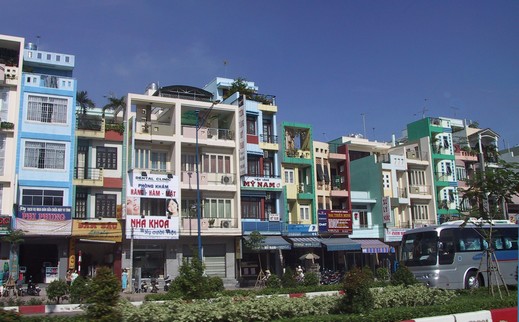
As we drove back to Ho Chi Minh City from the tunnels, on a wonderful wide double lane road, we noticed brightly coloured tall narrow buildings – stores on the bottom and obviously apartments above. Our guide explained that the road had relatively recently been widened. However, to widen it, the thousands of stores and homes that crowded the sides of the original road had to be removed. The government built new stores and apartments for everyone, but only to the width of the ones that were demolished. The individual owners can build higher if they want to and obviously a few have.
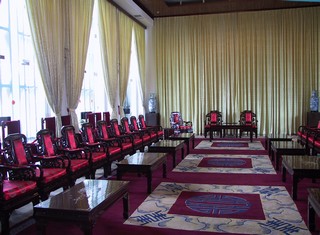
The following day we visited the Re-unification Palace, on the site of the palace of the French governor and later the presidential palace for South Vietnam. This is the Foreign Dignitaries Reception Hall. It was from the grounds of this building that the final American evacuation from Saigon took place and is the site of the official handover of power during the fall of Saigon on April 30,1975.
Afterwards, at the War Remnants Museum we were able to get a perspective of the war in Viet Nam from the point of view of the people of Viet Nam.
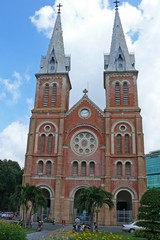
The afternoon we spent on our own checking out the area around out hotel. Just down the street was a half scale replica of Notre Dame Cathederal – beautiful – a reminder of the French occupation of the country.
We stopped to listen to a group of musicians who had set up on the steps of the Opera House. From the quality of their music we expect that they were professionals. They drew a large audiance.
That evening we had dinner at the other historic hotel – the Rex – and another stroll around the central square enjoying the cooler evening.
The next morning we headed out to the airport for our flight to Hanoi.
Bernie and Ross
Posted by Bernice at 04:45 PM | Comments (3)
June 27, 2007
Cambodia - Angkor Wat & the Tonle Sap
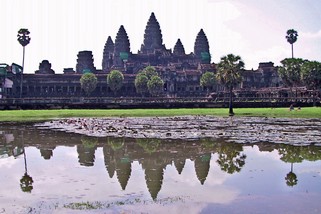 Our day, Tuesday, May 29th, began with a short hour and fifteen minute flight from Bangkok to Siem Reap, Cambodia, site of Angkor, an ancient city in northwestern Cambodia. Built between the ninth and fourteenth centuries, while it was the capital of Cambodia. It was abandoned in the early 1400’s, only to be ‘rediscovered’ and unearthed by French archaeologists beginning around 1863 and continuing for about 100 years. Pillaging and damage was done during the political upheavals of the Khmer Rouge in the 60's and 70's.
Our day, Tuesday, May 29th, began with a short hour and fifteen minute flight from Bangkok to Siem Reap, Cambodia, site of Angkor, an ancient city in northwestern Cambodia. Built between the ninth and fourteenth centuries, while it was the capital of Cambodia. It was abandoned in the early 1400’s, only to be ‘rediscovered’ and unearthed by French archaeologists beginning around 1863 and continuing for about 100 years. Pillaging and damage was done during the political upheavals of the Khmer Rouge in the 60's and 70's.
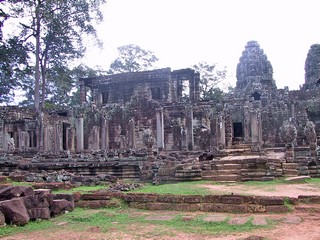 In 1987 the Indian government began a 7 year restoration of Angkor Wat (temple), the largest single complex in the city. Since 1991 the United Nations Educational, Scientific, and Cultural Organization (UNESCO) has helped the Cambodian government coordinate an international effort to research and preserve the sites in Angkor National Park and in that year it was classified as a UNESCO site and Cambodian National Park.
In 1987 the Indian government began a 7 year restoration of Angkor Wat (temple), the largest single complex in the city. Since 1991 the United Nations Educational, Scientific, and Cultural Organization (UNESCO) has helped the Cambodian government coordinate an international effort to research and preserve the sites in Angkor National Park and in that year it was classified as a UNESCO site and Cambodian National Park.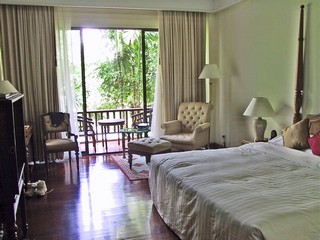
We were checked into the beautiful Sofitel Royal Angkor Hotel, located on Charles de Gaulle Boulevard. As we found throughout SE Asia, the French influence of a past era was very obvious.
We then headed immediately for the park, about a 15 minute drive away. Guess what? It is as hot as h… here too, but the local population including Nak, our guide, was well dressed in long trousers and dress shirts and looked quite comfortable. After getting our photo-ID pass, we began what would take nearly 3 days, to visit all there was to see. 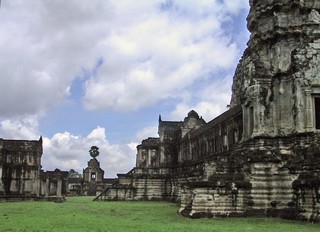
The temple itself is within a walled enclosure which is about 2800 by 3300 feet (850 by 1000 metres) which is within the park of approximately 60 square miles. It becomes more and more difficult to find words other than, beautiful, spectacular, impressive, etc. to describe these world-renowned historical sites we have visited, but this area must rank near the top of our list.
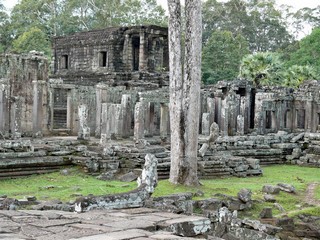
Again we realized that all this work was done by hand and basic machinery – no cranes, bulldozers or big trucks. Massive stone work cut to size by hand and then put in place by the workers (many of them slaves or prisoners).
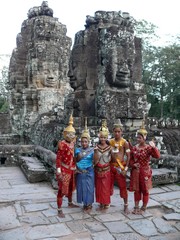
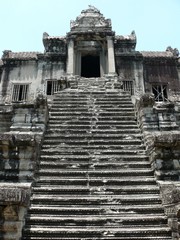 The next day we set out again with a full day of sightseeing and building explorations, including climbing to the top of a very old temple on a mountaintop near sunset, with many hundreds of others. Although there were steps to the top it was more like climbing a ladder because of the steep angle. It’s hard to believe that people used to live and worship there.
The next day we set out again with a full day of sightseeing and building explorations, including climbing to the top of a very old temple on a mountaintop near sunset, with many hundreds of others. Although there were steps to the top it was more like climbing a ladder because of the steep angle. It’s hard to believe that people used to live and worship there.
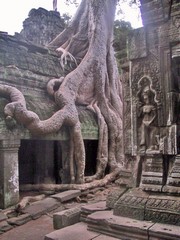
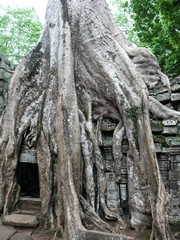 We explored Ta Prohm, a major temple. This site has been left with no restoration, only stabilization of the structure. The trees have taken over and support many walls and buildings. Some are nearly 40 feet in circumference, as the pictures show. The roots look like giant fingers holding up the walls. Just for perspective of size, the dark openings are doorways and arches.
We explored Ta Prohm, a major temple. This site has been left with no restoration, only stabilization of the structure. The trees have taken over and support many walls and buildings. Some are nearly 40 feet in circumference, as the pictures show. The roots look like giant fingers holding up the walls. Just for perspective of size, the dark openings are doorways and arches.
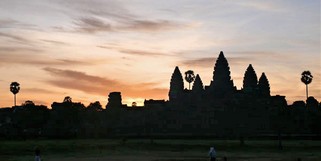 Our final visit to Angkor Wat was at 5:30 AM the third day for sunrise. Along with a thousand or so others (mostly tourists like us), we waited for the sun to appear over the roofs of the temple. Although it was very early, it was certainly worth going to see. It was also the coolest we had been – but – as soon as the sun came up, the heat came up with it.
Our final visit to Angkor Wat was at 5:30 AM the third day for sunrise. Along with a thousand or so others (mostly tourists like us), we waited for the sun to appear over the roofs of the temple. Although it was very early, it was certainly worth going to see. It was also the coolest we had been – but – as soon as the sun came up, the heat came up with it.
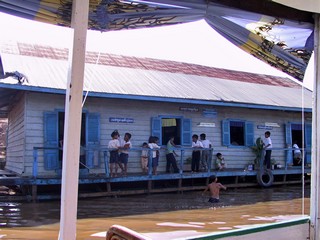 We returned to the hotel for breakfast and then immediately, left again for a boat trip on Tonle Sap Lake, the largest lake in SE Asia and one of the best sources of freshwater fish in the world. We cruised past floating homes, a school, churches, stores, restaurants and gift shops along the riverbank and in the lake.
We returned to the hotel for breakfast and then immediately, left again for a boat trip on Tonle Sap Lake, the largest lake in SE Asia and one of the best sources of freshwater fish in the world. We cruised past floating homes, a school, churches, stores, restaurants and gift shops along the riverbank and in the lake.
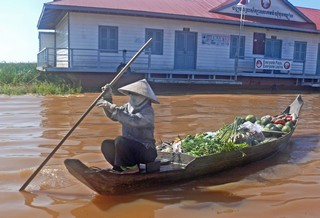
A fruit and vegetable vendor. 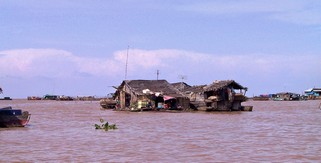
There were many floating houses on the lake. In the dry season the lake can be only a metre deep and have an area of 2,700 square km, but in the monsoon season is as much as 9 meters deep with an area of 16,000 square km.
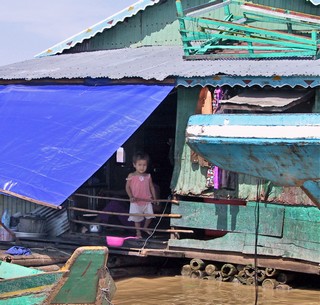
A little girl inspected us as we floated past.
The water was a very muddy colour and apparently was THE source of water for bathing, swimming and whatever daily needs there were for water, although we didn’t hear that they drank it.
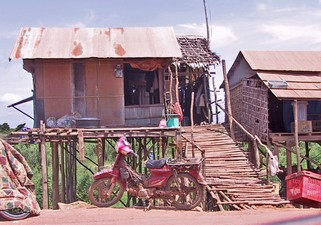
The houses along the banks that were not floating were set high on stilts to accommodate the flooding during the rainy season. At that time the lake covers the road we were driving on and everyone uses boats.
We headed back to Siem Reap for our transfer to the airport.
Three countries done ( plus Hong Kong) - one to go.
Viet Nam here we come.
Ross & Bernie
Posted by Bernice at 01:24 PM | Comments (0)
June 26, 2007
Thailand Part III - Bridge on the River Kwai
The 1957 motion picture, The Bridge on the River Kwai, won 7 Academy Awards and 3 Golden Globes at the 1958 awards ceremonies. The site is now a major tourist attraction in Thailand, about a 3 hour drive west of Bangkok in Kanchanaburi province.We left just after breakfast on May 28th on a tour bus with people from a number of downtown hotels.The morning rush hour in Bangkok was the same as everywhere we had been - too much traffic, too few roads.
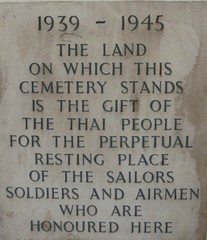
Just after 11, we arrived at one of 3 national memorial cemeteries dedicated to the memory of the thousands of Allied POWs who died during the construction of 2 bridges, the first of wood and the second of steel (the wood bridge was destroyed in a bombing raid).The bridge over the Kwai River was part of the Death Railway, a rail line built by the Japanese to link Burma (now Myanmar) with the w:st="on">Gulf of Thailand.
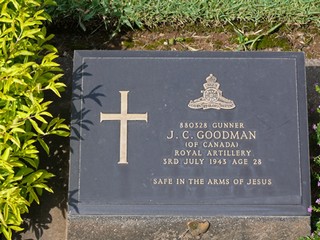
The cemetery was very beautifully maintained and we were able to find the marker of one Canadian buried there.
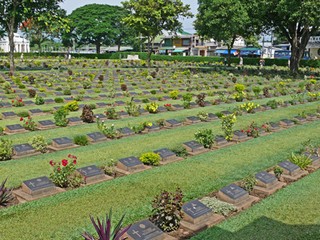
Each of the several hundred markers was done in the same manner with name, regiment, rank and age, plus most had a one line message from family as well. It was quite an emotional few minutes for each of us, even though we did not know anyone buried there.
We then headed to the river with a stop at the museum. It was again very hot and humid and the bamboo building was not air conditioned. The displays are quite old and only in fair condition but most were original newspaper reports and photos, letters from the prisoners, diary entries and similar very personal items. After reading these real reports, it seems a miracle that anyone lived through the ordeal
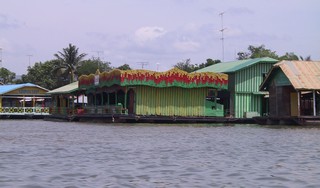 We then boarded what appeared to be home-made boats with about 6 people in each, and when loaded, were only about 6 inches out of the water. The ride down stream to the bridge took about ten minutes. The area is now very commercial with restaurants and bazaars but I’m sure that 65 years ago it was raw jungle. With nine steel spans made in Japan, the bridge is 522 metres. >
We then boarded what appeared to be home-made boats with about 6 people in each, and when loaded, were only about 6 inches out of the water. The ride down stream to the bridge took about ten minutes. The area is now very commercial with restaurants and bazaars but I’m sure that 65 years ago it was raw jungle. With nine steel spans made in Japan, the bridge is 522 metres. >
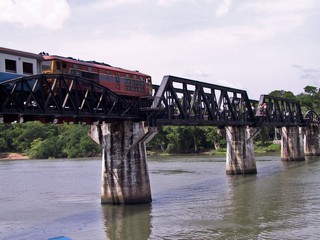
The rail system the bridge was built for is still in use every day and we were fortunate enough to be there when the mid-day passenger local crossed.As many of you know my hobby for 30 years has been trains so it was interesting for me to see the local train.
We went by bus to an outdoor restaurant for lunch and then boarded the train for a 30 minute ride back to the town where the cemetery was located.
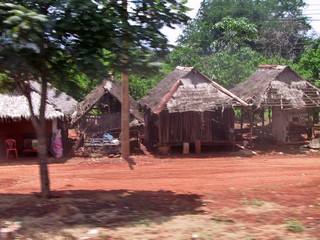
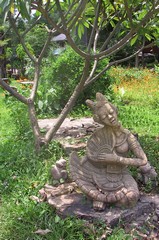
This was our view of the village while we waited for the train – and almost hidden in the grass, was this wonderful statue. We discovered them in the most unusual places.
We left the train, and headed to our bus for the ride back to Bangkok. The bus was parked on the other side of the tourist shopping area so we had to walk past all the stalls to get to it. Excellent and we’re sure planned place to park.
We arrived back in Bangkok about 5:30 after a most interesting day to a world famous historical site.
The next day we left for Siem Rep, Cambodia and the ancient city of Angkor
Ross & Bernie
Posted by Bernice at 01:08 PM | Comments (1)
June 25, 2007
Thailand Part II - Bangkok
Going from China to other south-east Asian countries is like going from Ontario to PEI, the size difference is huge. Our flight between Chiang Mai and Bangkok took only 70 minutes. Thailand, just slightly larger than Manitoba, is one of the first foreign countries I can remember learning about. It was then called Siam and Yul Brenner and Debra Kerr were starring in the King and I. Today 60+ million people live there and everyone we met was courteous, gentle, helpful and personable. The consultant Cambridge Travel uses, said it was her favourite country out of about 80 she has visited.
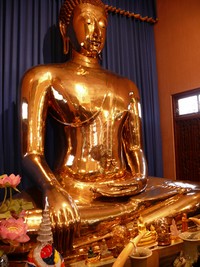
As in each previously visited city, our day began with a city tour. Thailand has over 25,000 temples (called Wats) so every tour includes 2 or 3 of their best. The first, Wat Trimitr (Temple of the Golden Buddha), was just what its name implied. Five and a half TONS of SOLID GOLD, set in a beautiful park-like setting near the city centre. It was discovered, beneath a layer of stucco, while the temple was under re-construction.
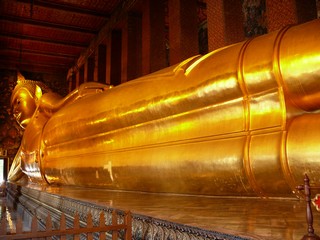
The next stop was Wat Po (Temple of the Reclining Buddha). The statue is about 15 metres (45 feet) long and is painted with 24 karat gold.
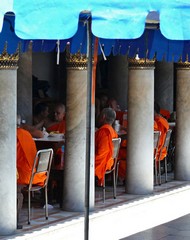
It was interesting to see the monks, all of whom wear a bright orange toga, sitting having breakfast beside the temple. 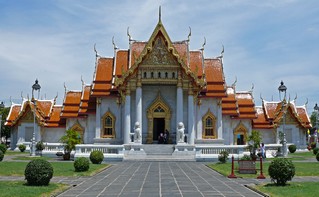
It the afternoon we enjoyed a cruise on the Chao Phraya River through the middle of Bangkok. It functions almost like another expressway, with boats of all types, both freight and passenger, coming and going constantly.
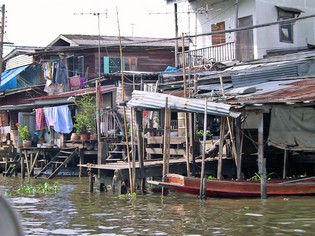
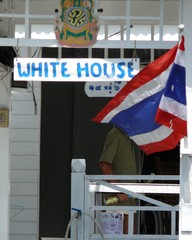
Many commercial establishments are accessed from the river frontage and people live in homes built right on the river, including the White House.
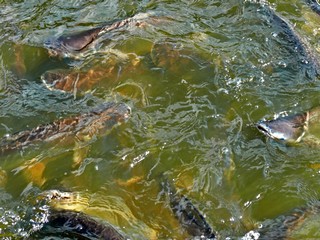 Part way through the trip we were transferred to a rice barge for a mid-afternoon lunch. These boats were originally used to transport rice but have been converted for tourist service. We stopped in mid river and were given bags of bread crumbs which attracted hundreds of big cat fish (18-24”) when we threw the crumbs overboard. The water boiled with the frenzy of the fish to feed. When we tried again a hundred metres downstream – there were no fish.
Part way through the trip we were transferred to a rice barge for a mid-afternoon lunch. These boats were originally used to transport rice but have been converted for tourist service. We stopped in mid river and were given bags of bread crumbs which attracted hundreds of big cat fish (18-24”) when we threw the crumbs overboard. The water boiled with the frenzy of the fish to feed. When we tried again a hundred metres downstream – there were no fish.
During this part of our trip, meals were not included, so we set out downtown for dinners and found a couple of great places with excellent food. The temperatures were in the very humid 30s which we found almost overpowering at times. Many establishments are not air conditioned.
An all day trip, to the famous Bridge on the River Kwai, meant an eary start the following day. Please join us there.
Ross & Bernie
Posted by Bernice at 07:54 AM | Comments (1)
June 24, 2007
Thailand Part I - Chiang Mai
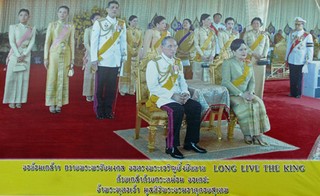 On Thursday May 24th, we arrived in Chiang Mai just after 7 PM. When we planned our trip to SE Asia, we included Thailand. Judy, our agent at Cambridge Travel, suggested we visit this second-sized city in the north of the country. After clearing immigration, we departed for Belle Villa Resort (an RCI resort), about an hour from the airport via a twisting, hilly road. As we were driving, we noticed many signs and billboards with pictures of the King and Queen and/or the royal family. The King's 80th birthday is 2007 and everywhere we went in Thailand were displays of the peoples’ love for their king.
On Thursday May 24th, we arrived in Chiang Mai just after 7 PM. When we planned our trip to SE Asia, we included Thailand. Judy, our agent at Cambridge Travel, suggested we visit this second-sized city in the north of the country. After clearing immigration, we departed for Belle Villa Resort (an RCI resort), about an hour from the airport via a twisting, hilly road. As we were driving, we noticed many signs and billboards with pictures of the King and Queen and/or the royal family. The King's 80th birthday is 2007 and everywhere we went in Thailand were displays of the peoples’ love for their king.
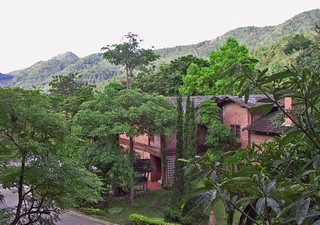 The resort was beautiful and we enjoyed a wonderful dinner on the outdoor dining deck. The Thai people are very calm and gentle and the evening was a wonderful contrast to Hong Kong. There were few guests but the service and food were superb. It was sultry, the tree frogs and night sounds were a sound track for the sheet lightning, lighting the sky through the clouds. The ceiling fans rotated slowly cutting the hot humid air. Bernie leaned across the table to me and asked, if she turned around, would Humphrey Bogart be sitting at the next table. It was just that kind of atmosphere.
The resort was beautiful and we enjoyed a wonderful dinner on the outdoor dining deck. The Thai people are very calm and gentle and the evening was a wonderful contrast to Hong Kong. There were few guests but the service and food were superb. It was sultry, the tree frogs and night sounds were a sound track for the sheet lightning, lighting the sky through the clouds. The ceiling fans rotated slowly cutting the hot humid air. Bernie leaned across the table to me and asked, if she turned around, would Humphrey Bogart be sitting at the next table. It was just that kind of atmosphere. 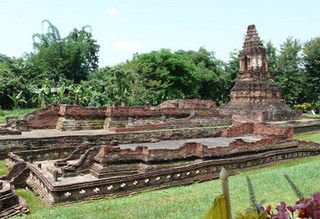
The morning dawned crystal clear and warm. Our guide, Bua, picked us up for a tour of Wiang Kum Kam, an ancient city buried and lost for almost 200 years following a massive flood.
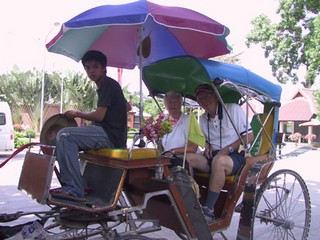 Our itinerary said ‘by bicycle’ but we were taken by horse-drawn taxi instead, which we were pleased with because it was 30+ degrees. We stopped at a downtown grocery while Bua and Bernie bought fruit and snacks and then continued with a tour of the city’s historic places, including more temples, monuments and the Art and Cultural Hall, featuring a wonderful depiction of the area’s history.
Our itinerary said ‘by bicycle’ but we were taken by horse-drawn taxi instead, which we were pleased with because it was 30+ degrees. We stopped at a downtown grocery while Bua and Bernie bought fruit and snacks and then continued with a tour of the city’s historic places, including more temples, monuments and the Art and Cultural Hall, featuring a wonderful depiction of the area’s history.
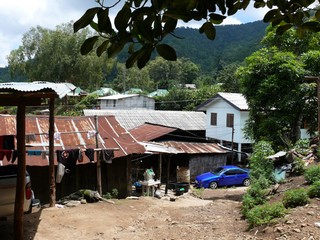 Our second day featured a drive up Doi Suthep Peak to visit a Meo hill tribe who live on mountaintops above 3000 feet. They observe a very simple lifestyle, with hand-built modest homes (but with modern automobiles parked outside). It was a most interesting visit including displays of local crafts. The residents, who had quite a different appearance to the Thai people we had seen, were quite friendly. On the road to their village we passed the king’s summer residence. One of the interesting little experiences we had on this tour was that our driver from the hotel stopped about halfway to the peak and we took a second vehicle to the village. It was not a production car but rather a half truck/half taxi and the driver obviously knew every twist and turn in the road. We were glad it was daylight.
Our second day featured a drive up Doi Suthep Peak to visit a Meo hill tribe who live on mountaintops above 3000 feet. They observe a very simple lifestyle, with hand-built modest homes (but with modern automobiles parked outside). It was a most interesting visit including displays of local crafts. The residents, who had quite a different appearance to the Thai people we had seen, were quite friendly. On the road to their village we passed the king’s summer residence. One of the interesting little experiences we had on this tour was that our driver from the hotel stopped about halfway to the peak and we took a second vehicle to the village. It was not a production car but rather a half truck/half taxi and the driver obviously knew every twist and turn in the road. We were glad it was daylight.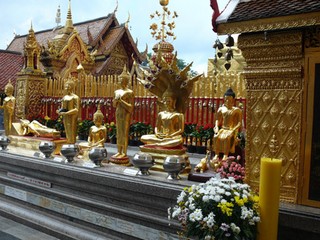
After coming down, we were taken to the most sacred temple in northern Thailand, built in 1384 AD. There were 300 steps from the parking area to get there, but fortunately there was also an elevator (whew!!). The view of Chiang Mai was wonderful and the temple, Wat Phra That Doi Suthep, was one of the most beautiful we have visited so far.
We returned to the hotel for lunch and then left for the airport for our flight to Bangkok, the capital.
Please join with us in our next journal.
Ross and Bernie
Posted by Bernice at 11:31 PM | Comments (2)
June 23, 2007
Hong Kong
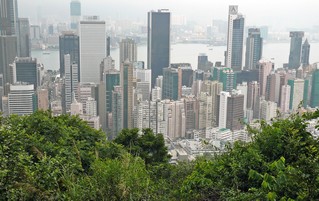 We didn’t hear whether Hong Kong/Kowloon has a slogan, but it might be “the city of highrises. If we thought it would be significantly different than the other Chinese cities on our tour because of its British heritage, it was not. With over 6 million people on a few islands and a bit of mainland peninsula, it turned out to be the busiest, more bustling part of our trip. We stayed at the Kimberly Hotel in Kowloon (the mainland), about a block from the main thoroughfare Nathan Road, right in the middle of the action.
We didn’t hear whether Hong Kong/Kowloon has a slogan, but it might be “the city of highrises. If we thought it would be significantly different than the other Chinese cities on our tour because of its British heritage, it was not. With over 6 million people on a few islands and a bit of mainland peninsula, it turned out to be the busiest, more bustling part of our trip. We stayed at the Kimberly Hotel in Kowloon (the mainland), about a block from the main thoroughfare Nathan Road, right in the middle of the action.
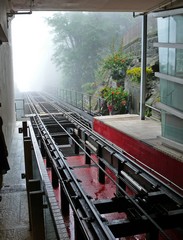
Our first sightseeing stop on the island of Hong Kong, was Victoria Peak, the mountaintop tourist viewing outlook reached by an incline railway. Unfortunately it was raining and very misty, but due to the magic of Adobe Photoshop, we were able to create some good photos. The one above was taken about half way up.
After a bus ride down from the top, past some of Hong Kong’s most expensive private homes, we took a sampan tour of the famous floating community of Aberdeen, part of Hong Kong harbour.
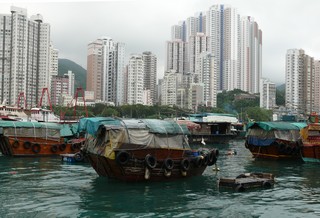
As you can see, in this city like so many in China, old meets new.
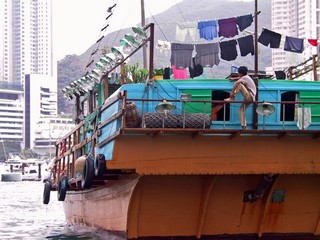
Not only is business carried on on the water but that is where the community also lives and spends most of their lives.
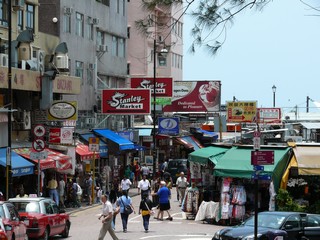
In every city we visited, we toured a market and here was no exception.With 2 world famous bazaars Stanley Market in the daytime and Temple Street Market in the evening – there was more than enough opportunity to sharpen our negotiating skills. KFC, McDonald's and Pizza Hut were side by side with every imaginable choice of Chinese cuisine.
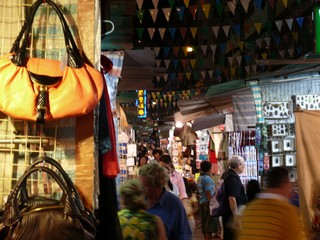 In China, it is expected that employees do not leave work until after their superior does, so - the workday starts early and finishes in early evening. The streets then come alive with commuters and shoppers and temporary food vendors, usually preparing only one food item, so you line up 2 or 3 times for your supper.
In China, it is expected that employees do not leave work until after their superior does, so - the workday starts early and finishes in early evening. The streets then come alive with commuters and shoppers and temporary food vendors, usually preparing only one food item, so you line up 2 or 3 times for your supper.
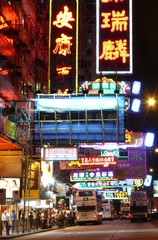
Street hawkers offer custom tailored suits (overnight), GENUINE COPY watches, city tours, jewelry, laundry and almost any other commodity you might desire. Nathan Street is lined with signs in Chinese (Mandarin is spoken in Hong Kong and English. Many of the signs are larger than the shops that sell the merchandise.
The city has nearly a thousand very modern double-decker buses. It is hard to imagine how bad the traffic would be without them.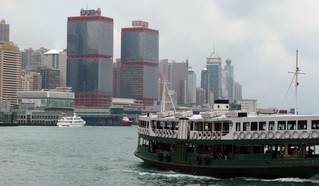 The next day was “at leisure”, meaning no organized tour events, so we set out on foot to see more of the area. We walked to the harbour and took the Star Ferry to Hong Kong island. It is free for seniors. One of the worlds best hotels, The Peninsula, tucked in among dozens of condominiums and office buildings, faces the waterfront. The city is absolutely modern and enjoys some freedom from Chinese rules and regulations. We have never seen so many highrise towers, most very imaginatively designed. Everywhere we looked more were under construction. We concluded that Hong Kong was a great place to visit, but we wouldn't want to live there.
The next day was “at leisure”, meaning no organized tour events, so we set out on foot to see more of the area. We walked to the harbour and took the Star Ferry to Hong Kong island. It is free for seniors. One of the worlds best hotels, The Peninsula, tucked in among dozens of condominiums and office buildings, faces the waterfront. The city is absolutely modern and enjoys some freedom from Chinese rules and regulations. We have never seen so many highrise towers, most very imaginatively designed. Everywhere we looked more were under construction. We concluded that Hong Kong was a great place to visit, but we wouldn't want to live there. Later that afternoon, 3 of our friends from the tour left to return to Canada, one couple stayed in Hong Kong for a few more days and we headed to the airport for our flight to Chiang Mai, Thailand, our next journal entry.
Ross & Bernie
p.s: Bernie has returned to work at her former company in Toronto, as interim General Manager until November 15, so Ross is pinch hitting as journal author.
Posted by Bernice at 11:49 PM | Comments (2)
June 22, 2007
China Part VI - Beijing
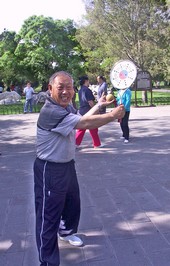
The Temple of Heaven is set in a large park and seems to be a meeting place for senior citizens of Beijing. There were groups singing, ballroom dancing, doing tai chi and playing badminton.
One gentleman tried to teach me the routine he was performing with a ball and paddle but my dexterity wasn’t as good as his. Neither of us spoke the other’s language but we didn’t need to, to enjoy those few minutes. 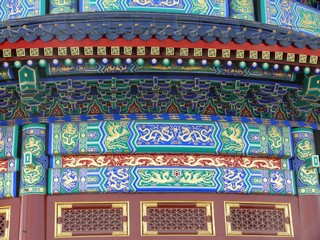
The Temple of Heaven was the place where the Emperors would worship heaven and pray for good harvests. It was first built in 1420 and is a wonderful example of China’s ancient architectural art. The picture below is the Hall of Prayer for Good Harvests and is decorated with intricate graphics that can be seen in the picture to the left.
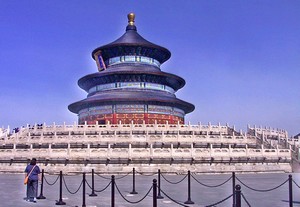
No nails or pegs were used in the construction and there are 50,000 glazed blue tiles (representing heaven) on the roof. The railings around it are white marble.
Tia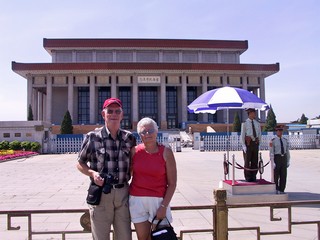 nanmen Square – we have all heard about it! It was the scene of massive (100,000 participants) political protests from April to June 1989 and the military crack down on the protesters left many civilians dead.
nanmen Square – we have all heard about it! It was the scene of massive (100,000 participants) political protests from April to June 1989 and the military crack down on the protesters left many civilians dead.
It is huge – 880 x 500 metres, a total of 440,000 square meters, which make it the largest open-urban square in the world. It is a modern creation with some walls of the Forbidden City removed to make way for it. Tiananmen (the Gate of Heavenly Peace) is the original front gate of the Imperial Palace and is one of the entrances for tourists visiting the Forbidden City. We are standing in front of the Mao Tse Tung Mausoleum which was closed due to construction on the entrances.
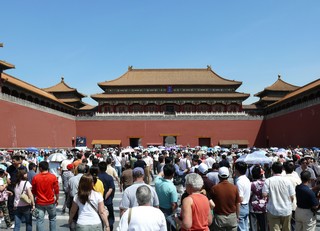 The Forbidden City is located in the absolute middle of Beijing and for 5 centuries was home to the Emperor and was also the ceremonial and political center of Chinese government. It took only 15 years to build starting in 1406 and required over one million workers. There still survive 980 buildings with 8,707 bays of rooms. At one time there were more than 20,000 rooms. And there were crowds – as you can see in this picture of one of the courtyards leading to the inner structures. There are three gateways in each wall as we moved toward the inner palace – the centre one for the emperor and the ones on either side for imperial concubines, officials, guards, artisans, etc.
The Forbidden City is located in the absolute middle of Beijing and for 5 centuries was home to the Emperor and was also the ceremonial and political center of Chinese government. It took only 15 years to build starting in 1406 and required over one million workers. There still survive 980 buildings with 8,707 bays of rooms. At one time there were more than 20,000 rooms. And there were crowds – as you can see in this picture of one of the courtyards leading to the inner structures. There are three gateways in each wall as we moved toward the inner palace – the centre one for the emperor and the ones on either side for imperial concubines, officials, guards, artisans, etc.
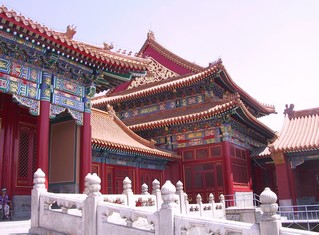
Beautiful colors and details.
Recently the presence of commercial enterprises in the City has become controversial. A Starbucks, which opened in 2000, and we saw on our visit, closed in July 2007 a couple of months after we were there.
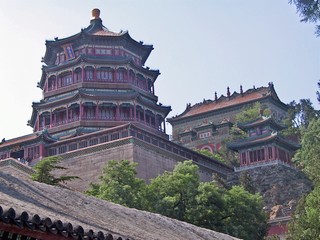
In the afternoon we visited the Summer Palace – the summer resort for the emperors. We took a boat to the wharf just below the palace and then walked a little under a kilometer back to the entrance gate through what is called the Long Corridor. The Corridor parallels the lake and there are fabulous paintings of Chinese history and legend inside the corridor.
The next morning we visited a silk carpet factory and after lunch a cloisonne factory before continuing on.
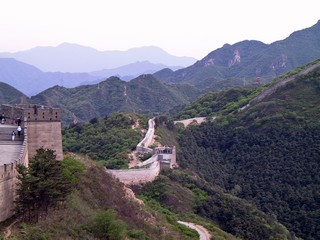 Finally, we arrived at the Great Wall!
Finally, we arrived at the Great Wall!
We, along with thousands of others, walked about a mile or more along this wonder. We were at the Badaling section of the wall which has been restored and is about 75 km from Beijing.
It is a series of stone and earthen fortifications built, rebuilt and maintained between the 5th and 16th centuries to protect the northern borders. It stretches approx 6,400 km (4,000 miles) along the southern edge of Inner Mongolia.
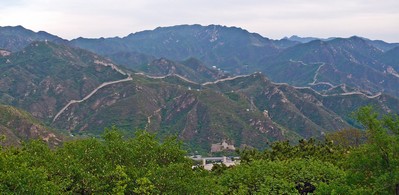 The wall hugs the contours of the terrain, and as it climbs up and down mountains, it keeps changing in height and width and building material. It has gate-towers for lodging and defence, passes and signal towers all with embrasures to allow shooting of arrows.
The wall hugs the contours of the terrain, and as it climbs up and down mountains, it keeps changing in height and width and building material. It has gate-towers for lodging and defence, passes and signal towers all with embrasures to allow shooting of arrows.
A visit we will never forget.
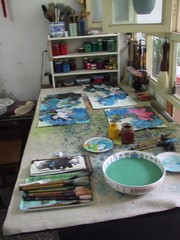
The next morning, May 21st, we visited the “hutongs”, alleys or lanes in the ancient part of Beijing. In the residential area, closed courtyards were built in a neat layout and hutongs were used to get around them. We toured them in a pedicab as many are too narrow for a vehicle. We were fortunate to be able to visit a local artist, Zhang Shuixing. His studio is in his living room. He is considered quite well to do as he owns the housing quadrangle and lives on one side, while renting out the other three sides.
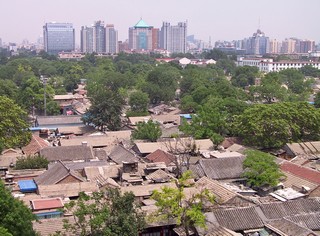
The contrast of the “Hutong” area with the new high rises of Beijing in the background.
Fortunately, many of these original residential areas are being preserved.
After lunch we visited the Silk Road Market where some serious shopping was done. It is a maze of small stalls with everything imaginable for sale. Yes – bargins!
That evening we went to a live theater show “The Legend of Kungfu” and then to the Hard Rock Cafe (western food!) for dinner.
We left Beijing for Hong Kong, after breakfast the next morning. A wonderful busy 2 weeks in a huge country. We certainly didn’t see anywhere near what was worthy of seeing but we did get a taste of the country and the people. We loved it and would recommend this trip to everyone who likes to travel.
But, there was more on our itinerary, so Hong Kong, it’s next in line!
Bernie & Ross
Posted by Bernice at 08:44 AM | Comments (2)
June 21, 2007
China Part V - Xian
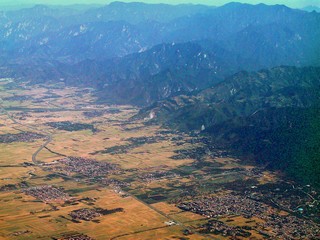 Our flight to the north east from Chongqing to Xi’an crossed the Qinling Mountains. The Yellow River flows to the north of the mountains and the Yangtze to the south.
Our flight to the north east from Chongqing to Xi’an crossed the Qinling Mountains. The Yellow River flows to the north of the mountains and the Yangtze to the south.
The mountains, from the air, appear to have no foothills. The Guanzhong Plain starts immediately and is very fertile and totally cultivated. Villages, towns and small cities are scattered everywhere. Xi’an, with a population of 8 million was called a small city.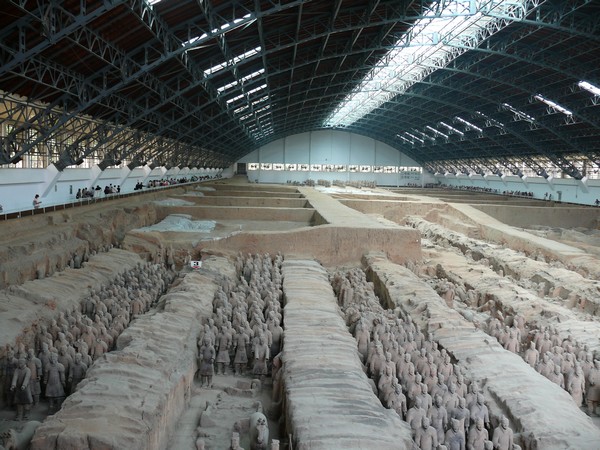
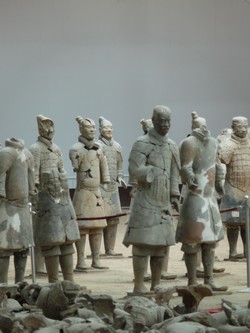 A jigsaw puzzle of immense proportions !
A jigsaw puzzle of immense proportions !
The Terrra Cotta Warriors were accidentally discovered in 1974, by a group of workers who were working on a well. The figures are from the Qin Dynasty from 221 – 206 B.C. They were created to protect the mausoleum of the emperor and to help rule another empire in the afterlife.
The above picture is Pit #1 covering about 3 1/2 acres, where there are more than 6,000 terra cotta warriors and horses in battle line formations. Close by there are 2 other smaller pits holding another 1,600 plus warriors, horses and chariots. .
The figures are life-sized The lower part of the body is solid, the upper hollow and the heads are separate. No two warriors are duplicated.
Huge buildings have been constructed to protect the pits and their contents from the elements while the work continues.
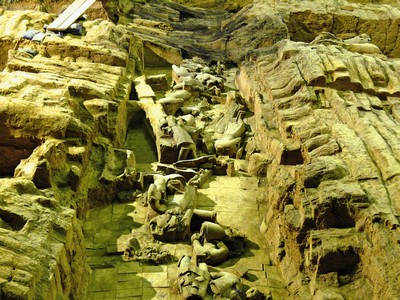
The figures were positioned in underground timber lined vaults but the site was ransacked, vandalized and set fire to, only a few years after the death of the First Emperor. Only one undamaged figure was found.
This picture shows one of the areas where archaeologists are unearthing the pieces.
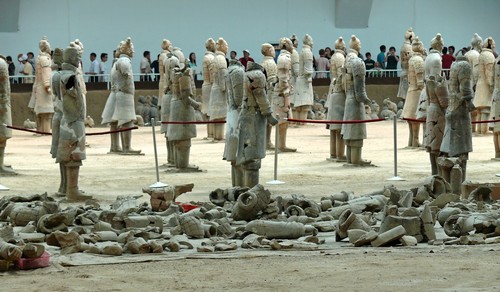
So – the jigsaw puzzle – the painstaking work of putting the figures back together, one by one continues.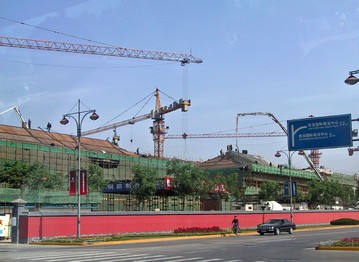
This was a familiar scene all over China.
Numerous cranes at building sites and buildings under construction, wrapped in green mesh.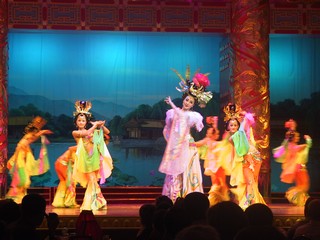
That evening we attended a cultural show with dinner at the Tang Dynasty Restaurant and Theater. The music and dance originated over one thousand years ago.
What a perfect performance to celebrate our fellow traveller, Alice’s birthday.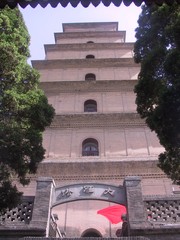
On Friday morning, May 18th, we walked to the Big Wild Goose Pagoda, which was quite close to our hotel.
This is one of the most famous Buddhist temples in China. It was built in 652 A.D. to preserve the manuscripts of Buddhist texts that were brought from India and subsequently translated into Chinese.
It is very simple, 7 stories high and built of layers of brick, with no cement.
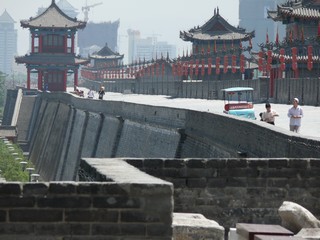
The old city of Xi’an is surrounded by a well preserved wall reconstructed in the Ming Dynasty. It is certainly wide and very flat, as the city is built on a plain. From this height, the views of the city are much better than from ground level.
After another excellent lunch (we certainly are being fed well), we headed to the airport for our afternoon flight to Beijing.
Bernie & Ross
Posted by Bernice at 06:18 PM | Comments (1)
June 20, 2007
China Part IV - Chongqing & Dazu
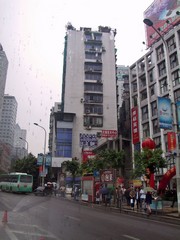 We disembarked our ship, the MV President #1 on Tuesday morning, May 15, in Chongqing. This was the only time that the tour company guide wasn’t on hand to meet us. We had to wait about 45 minutes for them to arrive after Judy got in touch to find out where they were. Best thing that could have happened – they bent over backwards for the next two days to make sure we saw and did everything. We were given all kinds of extras during the tours and at meals. We also had a super guide – Coco – who helped to make these two days great.
We disembarked our ship, the MV President #1 on Tuesday morning, May 15, in Chongqing. This was the only time that the tour company guide wasn’t on hand to meet us. We had to wait about 45 minutes for them to arrive after Judy got in touch to find out where they were. Best thing that could have happened – they bent over backwards for the next two days to make sure we saw and did everything. We were given all kinds of extras during the tours and at meals. We also had a super guide – Coco – who helped to make these two days great.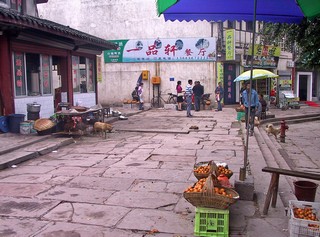
Chongqing is called “the mountain city” as it is built on hills and surrounded by mountains or “the river city” as 5 rivers cross it. It was raining most of the morning as we travelled throughout the area.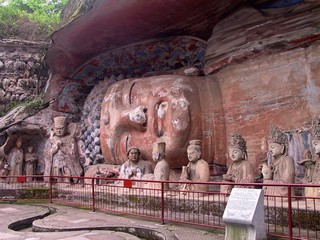
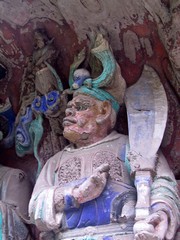
After an early lunch we drove about 130 km to the Baoding Grotto to view the rock carvings. Dazu Rock Carvings is the general name for over one-hundred cliff grottoes scattered throughout Dazu county. The construction of the grottoes began in the early 600s. They depict a wide range of subjects, stories and scenes from daily life. In total there are 60,000 statue carvings and 100,000 inscriptions in 75 locations. Our itinerary called for us to visit a second grotto however, after the 2 hour ride to get to Dazu and another 2 hours back, the group opted to visit a farm family compound instead. One of the advantages of having a smaller group – we could make those kinds of changes.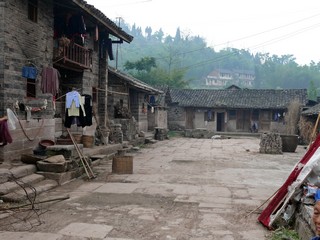
This farm compound is home to an extended family. It was built in a square with a central courtyard that led to each of the houses and also the buildings for animals and storage.
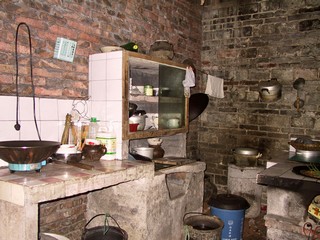
We were invited in to one of the houses and were impressed with the cleanliness even though the floors were dirt. In the bedroom, the bed was covered by a satin bedspread and the clothes hung carefully from the rafters.
In the kitchen, there was one electrical plug with extension cords to a light and a wok.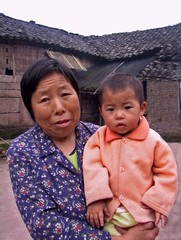
Grandmother seemed to be the one taking care of the little one. She was dressed in what we would consider more traditional clothing. The baby’s mother and other family members that we met were dressed in blue jeans, sneakers and T shirts.
There are many minority groups in China and the Tibetan heritage is evident in much of the population.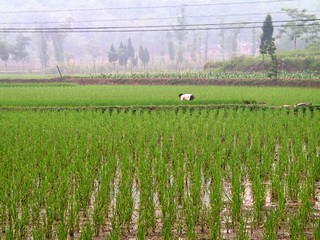
We passed acres and acres of rice paddies. Many were quite small with earthen dikes between the fields. In order to take advantage of every bit of land, the tops of the dikes, perhaps one foot wide, were often planted with corn.
This is back breaking work, as each seedling is planted by hand, bent over in a flooded field.
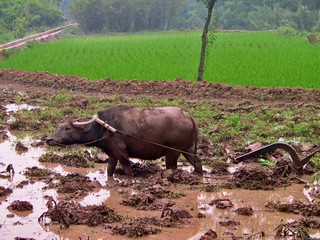
Although the rice fields in many places are first cultivated by machines, when they have been flooded, the water buffalo is still the only one that doesn’t get stuck.
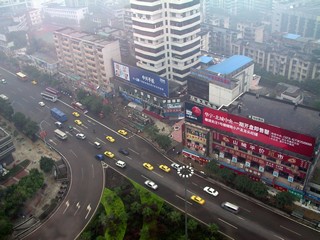
From the simplicity of the farm to the cosmopolitan of the city.
Looking down from our hotel.
From our observation each city has a colour for it’s taxis. We only saw yellow in Chongqing.
Early the next morning, we took the monorail to the Chongqing Zoo. We thought it strange as we went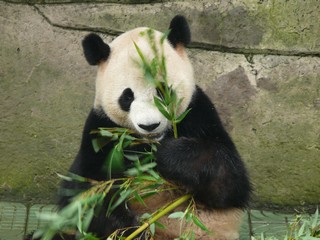 to board, we descended two very long escalators as if we were going into a subway. However, very shortly after boarding, the train came into the open. Turns out that with the mountains in the city the monorail sometimes has to tunnel through them.
to board, we descended two very long escalators as if we were going into a subway. However, very shortly after boarding, the train came into the open. Turns out that with the mountains in the city the monorail sometimes has to tunnel through them.
This was one of the adults and she will sit and eat bamboo half the day. Because bamboo has so few vitamins, a panda must consume up to 20 kg (44 lbs) a day. They eat all parts of the plant including the stems. In the zoo, they are given other types of food such as sugar cane, carrots, sweet potatoes and special high-fibre “panda bread”.
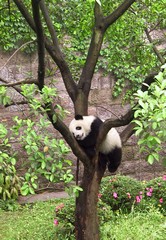
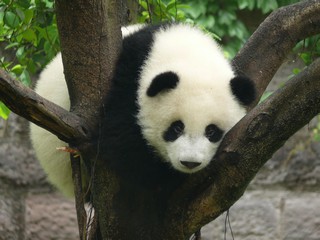
This is a year old baby that was born at this zoo. It was trying to get comfortable in the tree to have a sleep. Panda’s are not very active in captivity, interesting and endangered but not very active. I guess when you don’t have to forage for food 10 to 16 hours a day, you just get to sit around & eat instead.
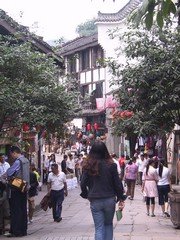
When we left the zoo we visited the Chiqikou old town area which has a history of more than 1,800 years. It is about an hours drive from the city centre and has been preserved in the midst of sprawling modern Chongqing. The name means porcelain harbour and the community prospered from the fancy blue and white porcelain of the Qing Dynasty.
The town was very busy with many vendors on the two main streets.
We had a 3 pm flight to our next stop, Xian, and after lunch we headed to the airport.
Xian is our jumping off point to see the Terracotta Warriors so our next journal is from there.
Bernie & Ross
Posted by Bernice at 02:31 PM | Comments (0)
June 18, 2007
China Part III - The Yangtze River
Our plane arrived in Yichang in mid afternoon and we immediately boarded a mini bus for our trip to board the ship for our Yangtze cruise. It was about a 2 hour trip, in pouring rain from the airport to the dock. We stopped for dinner on the way and also stopped at a convenience store to stock up on snacks and drinks for the cruise. As we neared the river we left the fertile plains and climbed through mountains. It was a challenge manuvering our luggage, down the steep stairs on the side of a cliff, in the dark, in pouring rain, to the deck of the ship – but we all made it with no mishaps.
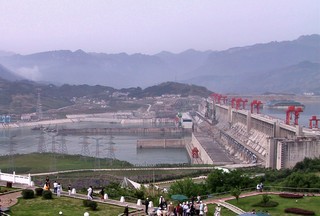 The Yangtze, which is the third biggest river in the world, meanders over 6,300 kilometers from its source to its estuary. The plains downstream from Yichang have been subject to massive flooding with flood levels 6 – 17 meters higher than normal.
The Yangtze, which is the third biggest river in the world, meanders over 6,300 kilometers from its source to its estuary. The plains downstream from Yichang have been subject to massive flooding with flood levels 6 – 17 meters higher than normal.
Close to Yichang, the Three Gorges Project is in the final stages of development. It is a massive dam, which when completed will provide flood control for 1,530,000 hectares (3,780,600 acres) of rich farm lands in the middle and lower reaches of the Yangtze river. It will also have a total generating capacity of 18,200 Megawatts, which is enough power to replace 40 to 50 million tons of raw coal combustion each year. As a comparison, the Grand Coulee on the Columbia River has an installed capacity of only 10,830 MW. Further, it will improve navigation capacity on the 660 km long waterway from Yichang City to Chongqing from 10 to 50 million tons as well as improve navigation below the dam in the dry season.
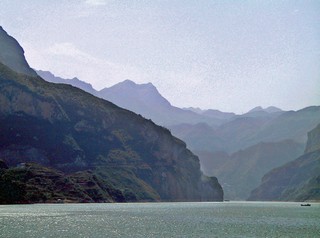 In the morning, the sun was out and we sailed upstream through 4 locks that are located beside the dam. This is a dual-channel five-step ship lock and also a one step vertical ship lift (under construction) As the water above the dam has not yet reached its maximum height, the fifth lock was not used by us. By now we were in the first -Xiling Gorge, 76 km long – of the Three Gorges.
In the morning, the sun was out and we sailed upstream through 4 locks that are located beside the dam. This is a dual-channel five-step ship lock and also a one step vertical ship lift (under construction) As the water above the dam has not yet reached its maximum height, the fifth lock was not used by us. By now we were in the first -Xiling Gorge, 76 km long – of the Three Gorges. 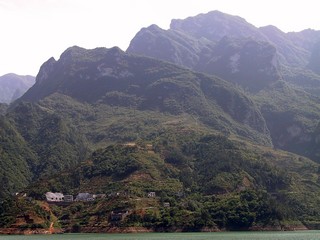
The mountains were right beside us, rugged, steep and mainly tree covered. Even with this difficult terrain, the edges close to the river were cultivated in steeply terraced fields. A roadway runs along the river, through many tunnels and over many bridges. However, the river remains the major transportation route.
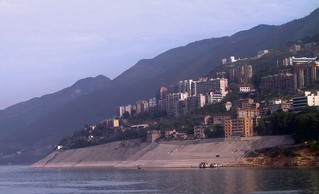 The normal river level, on completion, will be at 175 meters but was at about 150 meters as we sailed. There have been massive relocations of cities that would be covered by the water. New cities were built (this is one) above the new water line and the old cities have been demolished. The rubble was removed so it would not contaminate the water covering the old sites. About 1,136,000 million people have or will be resettled. Can you imagine the logistics to a project of that magnitude!
The normal river level, on completion, will be at 175 meters but was at about 150 meters as we sailed. There have been massive relocations of cities that would be covered by the water. New cities were built (this is one) above the new water line and the old cities have been demolished. The rubble was removed so it would not contaminate the water covering the old sites. About 1,136,000 million people have or will be resettled. Can you imagine the logistics to a project of that magnitude!
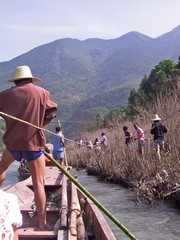
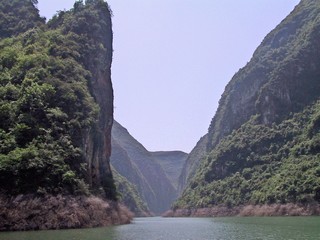
Early in the morning on day 2 of the cruise we took a smaller boat to travel up the scenic Shennong Stream and through its gorges. At the upper reaches we transfered to a flat bottomed wooden boat that was paddled by 8 very fit men. When the stream became too shallow, we were pulled upstream by the “trackers” on the riverbank.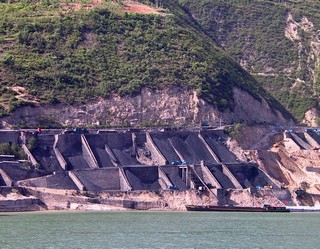
All along the river we have seen evidence of coal mining. These huge bunkers are built into the side of the mountain and the coal barges are loaded by gravity feed from them. With the majority of the electricity for the country generated by coal plants we understand the demand.
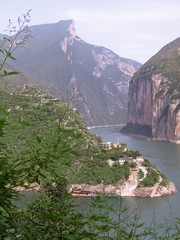 This view of the 8 km long third Gorge – Qutang – which we had just come through, was taken from White Emperor City. We climbed several hundred steps up Baidi Mountain to reach this complex which is almost 2,000 years old. Since the level of the river has been raised so much, the White Emperor City is now on an island.
This view of the 8 km long third Gorge – Qutang – which we had just come through, was taken from White Emperor City. We climbed several hundred steps up Baidi Mountain to reach this complex which is almost 2,000 years old. Since the level of the river has been raised so much, the White Emperor City is now on an island.
Along the sides of the steps as we went up were vendors, all wanting us to buy their product. The English they spoke related only to their sales and we don’t think they really understood those words either. As we passed by they called out “ Lady, lady, maybe later”. Not really a very good sales pitch!
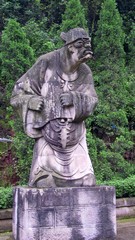
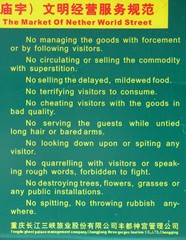
On our 3rd day on the river we visited Ghost City, where it is said that people checked in after their death. Many statues of ghosts and monsters bearing ferocious expressions and exaggerated poses are set throughout the buildings. One of the streets has many vendors and is called “The Market of the Nether World Street”. There was a sign posted that set out the conduct expected of the vendors. We particularly liked the 4th rule -“No terrifying visitors to consume”. We found English signage in all of the tourist areas, but they do certainly have a way with words.
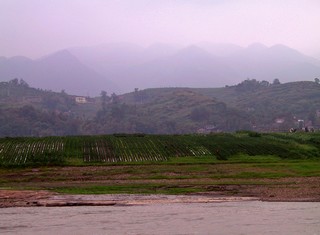
As we continued up the river that misty afternoon, the mountains receded and fertile fields took their place along the river. There was a lot of river traffic servicing the shoreline.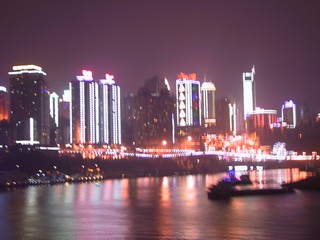
We arrived in Chongqing after dark and were intrigued by the light show from the buildings along the harbour. The shoreline was lined by brilliantly lit party boats and floating restaurants. At about 10 pm the boats shut off their lights and the buildings quickly followed suit. What a spectacular welcome at the end of our cruise.
We stayed on board that night and after breakfast the next morning, we disembarked for the next leg of our journey. We’re headed to the grotto carvings and the pandas.
Till then
Bernie & Ross
Posted by Bernice at 06:07 PM | Comments (5)
June 16, 2007
China Part II - Suzhou
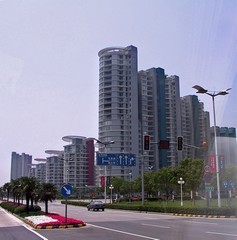
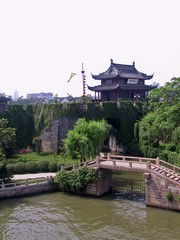
Suzhou, about 50 miles west of Shanghai, is situated on the lower Yangtze River on the shores of Lake Taihu and is renowned for its beautiful stone bridges, pagodas, canals and carefully designed gardens. It is a very modern city with new highrise apartments everywhere, many many close to the New Development Zone. This planned industrial area is now home to close to 100 major foreign enterprises – names like Dupont, Nike, Nabisco, Sanyo, Sony, Danone, Samsung, Shell and Mitsubishi.
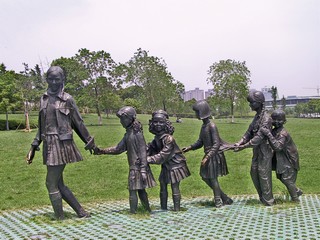
We visited Golden Rooster Lakeside, which is a beautifully groomed park across the lake from the industrial park.
There were many very interesting sculptures – this one of a group of children wading though the rice paddies. Music wafted gently in the air, from speakers hidden in bushes or disguised as rocks.
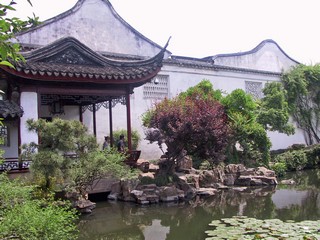
Suzhou has been proclaimed a UNESCO World Heritage Site due to its 2,000 year-old gardens. We visited the classic Chinese garden – the Master’s Nets Garden. They have wonderfully descriptive names for their gardens which were built long ago. Examples are: Humble Administrator’s Garden – 1509”, “Lion Grove Garden – 1342”, “Surging Wave Pavilion– 1044” and “Garden to Linger In – 1522.
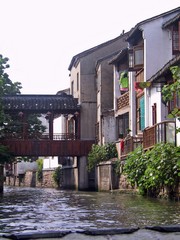
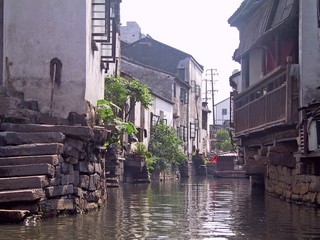
After lunch we took a cruise along The Grand Canal and also through some of the spider web of picturesque canals in the city. Now we know why Suzhou is called “ the Venice of the Orient”.
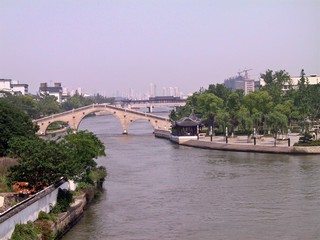 The Grand Canal, at 1,800 kilometers (1,080 miles) is the world’s longest man-made waterway. It runs north and south (most of China’s rivers flow east and west) and connects the Yangtze River valley and the Yellow River valley. Its building began in 486 B.C. and all parts were finally linked together by about 610 A.D.
The Grand Canal, at 1,800 kilometers (1,080 miles) is the world’s longest man-made waterway. It runs north and south (most of China’s rivers flow east and west) and connects the Yangtze River valley and the Yellow River valley. Its building began in 486 B.C. and all parts were finally linked together by about 610 A.D. 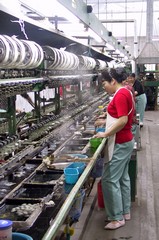 China has produced silk for at least 6,000 years and Suzhou is considered the silk capital of the country. From the mid 1300s to 1911 most of the high-grade silk produced for the royal families was made by Suzhou silk weavers. After our canal cruise we toured the Silk Embroidery Institute where we watched the production of silk from larva to finished product.
China has produced silk for at least 6,000 years and Suzhou is considered the silk capital of the country. From the mid 1300s to 1911 most of the high-grade silk produced for the royal families was made by Suzhou silk weavers. After our canal cruise we toured the Silk Embroidery Institute where we watched the production of silk from larva to finished product.
The cocoons are treated with boiling water to allow the silk filament to be separated. These women attach the filaments (which can be up to 1,000 meters in length from a single cocoon) to a bobbin which spins, unravelling the cocoon. Different grades of silk are used for different products, from comforters to fine clothing.
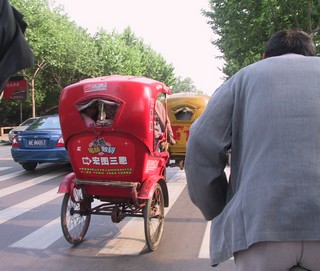 The next morning we left the hotel very early, by rickshaw, to visit a public park and then to go to the flower and bird market. These rickshaws are actually three wheeled bicycles and a number of the operators are middle aged men. There isn’t an ounce of excess fat on any of them.
The next morning we left the hotel very early, by rickshaw, to visit a public park and then to go to the flower and bird market. These rickshaws are actually three wheeled bicycles and a number of the operators are middle aged men. There isn’t an ounce of excess fat on any of them.
This was a most interesting ride as we shared the road with cars, buses, scooters and bicycles. If you want to get somewhere, you just go. Don’t stop – just go. Turning left across 6 lanes of traffic was an experience. Fortunately, my hair was already grey.
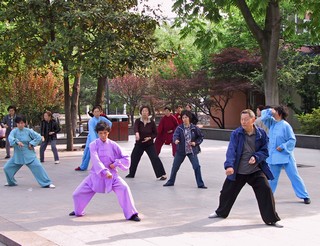
There were a number of groups practising Tai Chi in the park, as well as many other exercise and dance groups.
Throughout China, we found the parks to be used as an interactive social exercise facility. They aren’t just grass and trees. Sort of like an outdoor YMCA.
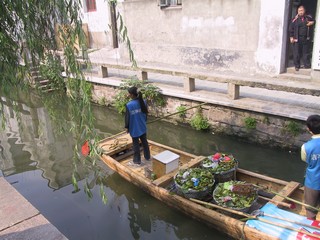
As we headed back toward our hotel we travelled beside one of the canals and watched the canal cleaners at work. All day they travel the waterways with scoops and nets, removing any leaves or debris that had fallen into the water. Once again, we were impressed with the cleanliness.
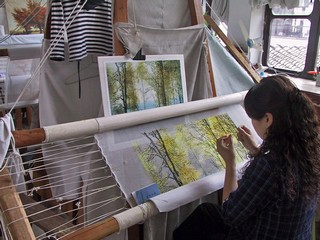 Before leaving Suzhou we visited The Lion Forest Garden where many of the rocks in the garden resembled Lions.
Before leaving Suzhou we visited The Lion Forest Garden where many of the rocks in the garden resembled Lions.
We also visited a workshop where beautiful pictures – landscapes, flowers and animals – are faithfully reproduced by silk embroidery.
After an early lunch we headed back toward Shanghai’s second airport for our 1:30 flight to Yichang. We had been so busy these first few days that we looked forward to our next segment – cruising the Yangtze River.
Bernie & Ross
Posted by Bernice at 09:23 PM | Comments (0)
June 14, 2007
China - A Country of Contrasts
The world’s largest electrical generating project, nearing completion (the Three Gorges Project on the
10,000,000 high school senior students who must write a marathon university entrance examination (several days), for only 5.5 million university spaces
More construction cranes than we have ever seen in one city, just blocks away from the Forbidden City and Mao’s tomb in
Huge cities –
REAL Chinese food everywhere (who would have guessed) – next door to McDonald’s, KFC and Pizza Hut.
Mandarin, Cantonese and more than 40 other languages of Asian peoples who migrated to
Every guide we had, when asked if it was safe for us to go out at night, said “absolutely”. Because family accommodation is so small, the streets are alive at night as friends and family meet.
Obese is not a word you hear much in
Most of the big cities have highrise apartments like North America but their designs are far more creative than ours, as is their use of bright colour trim and neon lighting for wonderful nighttime effects (plain gray concrete was not much in evidence).
Although nearly as large as
The most modern industrial complexes just a few miles from rice paddies being ploughed by water buffalo.
Posted by Bernice at 10:40 PM | Comments (1)
June 12, 2007
China Part I - Shanghai
As all of you know, we like to travel. North America is wonderful, but there are many, many other places to experience. About a year and a half ago we became interested in travelling to China. In conversations with various friends, we decided that if we were going that far, we should also see some other countries while we were away. Even though we were away 31 days, it is impossible to really see these countries in that limited time, but we do believe that we got a very good taste of them. Hopefully, in the next number of journals, (at this point I don’t know how many there will be) we can impart some of our experiences and the flavour of their cultures.
Cambridge Travel organized the tour and there were 7 of us travelling together, including Judy, their representative. We were met by local guides who remained with us while we were in each location. In China, all our hotels, meals and tours were included and prearranged. We didn’t rough it – we stayed in 4 & 5 star hotels. We ate too much – wonderful buffet breakfasts at the hotels and then full meals for both lunch and dinner at various locations. Because there were only 7 in the group, we were able to all sit at one table for meals, take mini vans for tours and travel (instead of big buses) and generally keep track of each other. Mind you, Irma & Judy liked to haggle with the street vendors who were everywhere, so we sometimes had to drag them away from their negotiations.
Sunday, May 6th at 11:35 PM, we left Toronto and 19 1/2 hours after leaving we arrived in Hong Kong where, after a 2 hour wait, we continued so that we arrived in Shanghai on May 8th, 24 hours after leaving Toronto. (We crossed the International Date Line, so May 7th for us was only a few hours) At this time of year there is a 12 hour (ahead) time difference between China and Toronto.
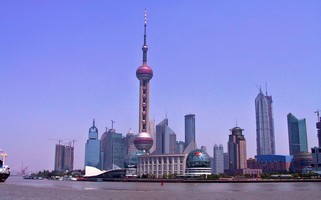 I’m not sure what we were expecting, but it wasn’t this extremely modern city with excellent landscaped road systems, unique colourful high rise buildings, modern facilities and clean, very clean.
I’m not sure what we were expecting, but it wasn’t this extremely modern city with excellent landscaped road systems, unique colourful high rise buildings, modern facilities and clean, very clean.
Before we even checked into our hotel we were taken to the “Bund”, the historic waterfront area once known as Shanghai’s Wall Street. This view is looking across the Huangpu River to the new commercial district in Pudong. The construction in Pudong only started in earnest in the mid 1990s.
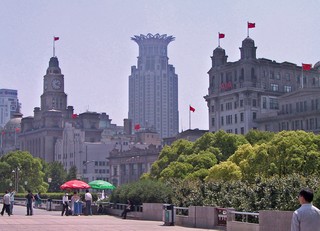
I turned around and then took this next picture. It shows the old financial area of the city. This was the “International Sector” during the late 19th and early 20th century when England and other European countries had a major presence in Shanghai.

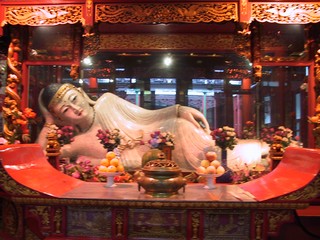
The next morning we visited the first of many temples, this one the Jade Buddha Temple. Built in 1882 in honour of two jade Buddhas from Myanmar (Burma). The sitting jade Buddha (no picture) is 1.9 metres tall and this one, the sleeping Buddha is .96 metres in length – each carved out of a single piece of jade.
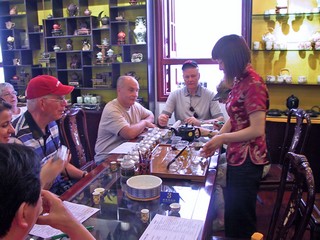
.
We completed our visit to the temple with a special tea ceremony, where we were served teas grown and cured by the monks. To them, tea is more than a drink – it is used as medicine and has been for hundreds of years.
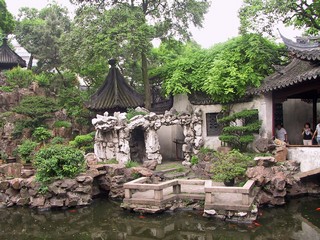 The following morning, we wandered our way through Yuyuan Gardens. This 450 year old landscape is considered to be the finest example of the classical garden style used in Shanghai. It is a paradise overflowing with traditional pavilions, halls , rockeries and ponds that are ingeniously separated by lattice walls and windows and winding corridors. The rocks were brought from the mountains miles away.
The following morning, we wandered our way through Yuyuan Gardens. This 450 year old landscape is considered to be the finest example of the classical garden style used in Shanghai. It is a paradise overflowing with traditional pavilions, halls , rockeries and ponds that are ingeniously separated by lattice walls and windows and winding corridors. The rocks were brought from the mountains miles away.
One famous rock, the Exquisite Jade Rock, is about 10.8 feet high and has 72 holes. If you burn a joss stick just below the rock, the smoke will float out from all of the holes. If you pour water into the rock from top, the water will flow out each hole.
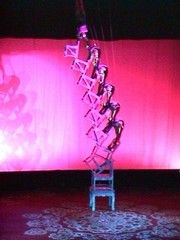
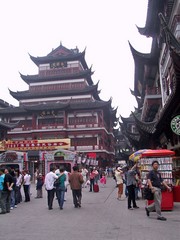 Just outside the Gardens (which is in the heart of Shanghai) is the Yu Garden Market where you can find more than 100 different shops and restaurants.
Just outside the Gardens (which is in the heart of Shanghai) is the Yu Garden Market where you can find more than 100 different shops and restaurants.
After an early dinner, we attended an amazing acrobatic show. The finale was the performers on stacked chairs – don’t try this at home!!
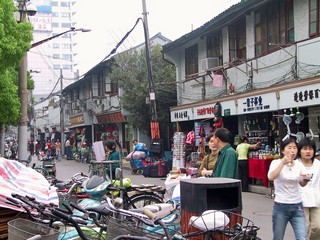
A typical shopping street – right outside the Yu Garden market area.
The next morning we headed out in a small bus to Suzhou (pronounced Soo chow), the Venice of the Orient. The next journal will tell of our visit there.
Bernie
Posted by Bernice at 02:39 PM | Comments (5)
June 10, 2007
On the road to Asia
Hello family and friends
As many of you know Bernie and I went to
We visited
In a word our trip was amazing!!!! We have been back a couple of weeks and Bernie still said to friends on Sunday that it’s hard to believe we actually went – it feels almost like a dream.
We took nearly 2000 digital photos so just editing them is quite a project. How do you condense your impression of
To begin with, getting there wasn’t half the fun. We left at 11:30 PM and arrived in
As most of you probably know
That’s all for now. More soon. Stay tuned.
Ross
Posted by Bernice at 11:21 PM | Comments (6)